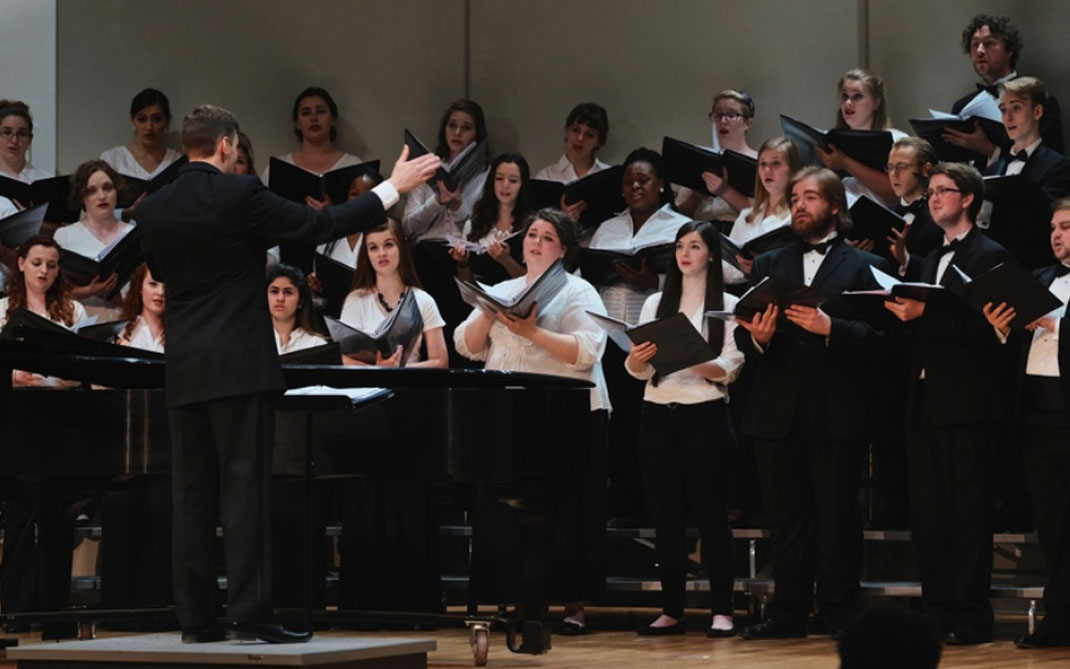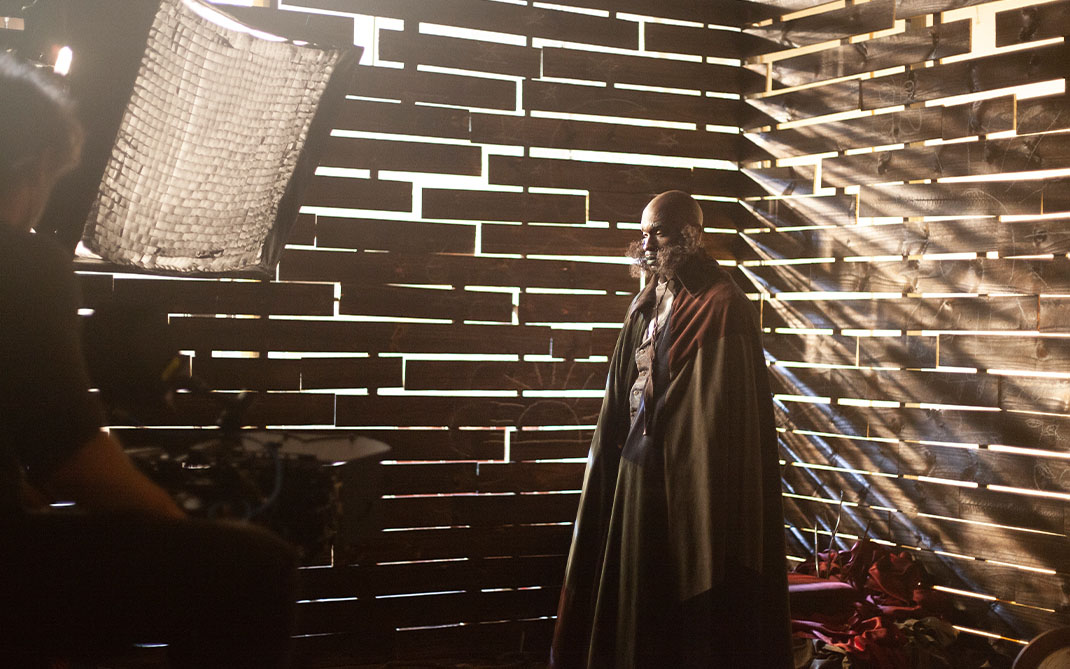Design & Production MFA Annual Report
Design & Production MFA Annual Report
The following Student Learning Objectives and assessment information is for Master of Fine Arts graduate programs in the School of Design & Production. Concentrations are offered in Costume Design, Costume Technology, Scenic Art, Scene Design, Sound Design, State Automation, Stage Properties, Technical Direction and Wig & Makeup Design.
Program Mission
The University of North Carolina School of the Arts, School of Design and Production is a professional school providing industry leadership and conservatory training in the fields of entertainment design, production technology, management and studio art to aspiring arts professionals.
Student Learning Objectives (SLOs)
SLO 1. Professionalism
Professionalism is often defined as the strict adherence to courtesy, honesty and responsibility when dealing with individuals or environment. This trait often includes a high level of excellence going above and beyond basic requirements. The good work ethic may include completing tasks in a timely manner with the highest quality possible and taking pride in completed tasks.
The students of Design and Production are expected to develop and demonstrate a level of professionalism by the end of each academic year, the highest level of professionalism by the end of their final year, with goals that need to be reached by a determined timeline. These set goals are evaluated per our Design and Production production rubric, which states the expectation and assessment guidelines along with a timeline of milestones.
Assessment Plans and Activities
Measure 1
Peer Production Evaluations – these are completed by the students at the end of each
production and evaluate themselves as individuals and as part of a team
Measure 2
Faculty Evaluations – these are evaluations that art completed at the end of each
semester
Evidence of Student Learning
Design and Production at the end of the Academic Year has collected Student Learning Outcome (SLO) reports from the Department Heads of the various disciplines within the school. These reports are compiled to create the School of Design and Productions annual SLO report. With hiring of a new Dean and a new University Administrative Manager (UAM) this past year, both not having the history or knowledge of this, these reports were not solicited from the faculty this year. Therefore, we have no sufficient data or information to create this annual report. The administration of the School of Design and Production, acknowledges this error and intends to remedy this in the next academic year. In conclusion we can report that as far as our students professional readiness, with an employment rate upon graduation of over ninety percent, we can conclude that our students are professionally ready to enter the workforce.
In our findings, we realize that the student learning outcome data could not be quantified statistically for comparison from year to year. We have determined that a numerical ranking system is needed. It is an integral component that we be able to rank the students and compare the annual assessment and verify that the expectations of both student and faculty are are achieved. The current system that is in use can and will be updated to meet this goal for the next academic year.
Interpretation
The School of Design and Production has demonstrated that we have been reviewing and
evaluating with multiple assessment tools in regards to Student Learning Outcome.
However, the data needs to reflective the entire body of students, in Design and Production,
with comparing and contrasting information to find the strengths and weakness of the
program in its entirety.
Design and Production needs to continue to review the student both by peer evaluations at the end of each production and by the faculty at the end of each semester. There needs to be put in place a formalized process to give standardized measure to rate the students with their peers.
Use of Student Learning Evidence
Design and Production needs to continue to review the student both by peer evaluations at the end of each production and by the faculty at the end of each semester. Their needs to be put in place a formalized process to give standardized measure to rate the students with their peers. Also, the rubric will need to be updated to reflect the ranking of the assessment process. This new standard will be a numerical system that can better translate the data and be a new benchmark. Design and Production (DEP) student learning outcome assessment plan must be updated and utilized throughout the assessment process of the School of Design and Production.
SLO 2. Innovation
The actions required creating new ideas, processes or products which, when implemented, lead to positive effective change. While invention requires the creation of new ideas, processes or products, innovation moves one step further and requires implementation of the inventive act. Innovation also implies a value system, which seeks to derive a positive outcome from the inventive act.
The students of Design and Production are expected to develop and demonstrate new and creative ways to tell the artist’s story by the end of each academic year. The innovation will be demonstrated by the effective collaboration with others (both students and faculty) to create a product that meets the requirements of a project from the beginning concepts, to the successful completion of the project.
Assessment Plans and Activities
Measure 1
Peer Production Evaluations – these are completed by the students at the end of each
production and evaluate themselves as individuals and as part of a team.
Measure 2
Faculty Evaluations – these are evaluations that are completed at the end of each
semester
Evidence of Student Learning
Design and Production at the end of the Academic Year has collected Student Learning Outcome (SLO) reports from the Department Heads of the various disciplines within the school. These reports are compiled to create the School of Design and Productions annual SLO report. With hiring of a new Dean and a new University Administrative Manager (UAM) this past year, both not having the history or knowledge of this, these reports were not solicited from the faculty this year. Therefore, we have no sufficient data or information to create this annual report. The administration of the School of Design and Production, acknowledges this error and intends to remedy this in the next academic year. In conclusion we can report that as far as our students professional readiness, with an employment rate upon graduation of over ninety percent, we can conclude that our students are professionally ready to enter the workforce.
In our findings, we realize that the student learning outcome data could not be quantified statistically for comparison from year to year. We have determined that a numerical ranking system is needed. It is an integral component that we be able to rank the students and compare the annual assessment and verify that the expectations of both student and faculty are are achieved. The current system that is in use can and will be updated to meet this goal for the next academic year.
Interpretation
The School of Design and Production has demonstrated that we have been reviewing and
evaluating with multiple assessment tools in regards to Student Learning Outcome.
However, the data needs to reflective the entire body of students, in Design and Production,
with comparing and contrasting information to find the strengths and weakness of the
program in its entirety.
Design and Production needs to continue to review the student both by peer evaluations at the end of each production and by the faculty at the end of each semester. There needs to be put in place a formalized process to give standardized measure to rate the students with their peers.
Use of Student Learning Evidence
SLO 3. Artistry & Craft
An incredibly talented person who dedicates the time and hard work to creating a beautiful work of art, be it a sculpture, painting or design. This person has dedicated years of work to mastering their craft, and deserve as much credit. They generally have a higher level of creativity and imagination.
The students of Design and Production are expected to show consistent growth in the areas of artistry and craft; and are assessed continuously throughout the process. The student is evaluated at the end of each academic year. The artistry and craft is demonstrated by storytelling through the work process and reflects a professional level of artistry as defined by the Design and Production (DEP) student learning outcome assessment plan.
Assessment Plans and Activities
Measure 1
Peer Production Evaluations – these are completed by the students at the end of each
production and evaluate themselves as individuals and as part of a team.
Measure 2
Faculty Evaluations – these are evaluations that are completed at the end of each
semester
Evidence of Student Learning
Design and Production at the end of the Academic Year has collected Student Learning Outcome (SLO) reports from the Department Heads of the various disciplines within the school. These reports are compiled to create the School of Design and Productions annual SLO report. With hiring of a new Dean and a new University Administrative Manager (UAM) this past year, both not having the history or knowledge of this, these reports were not solicited from the faculty this year. Therefore, we have no sufficient data or information to create this annual report. The administration of the School of Design and Production, acknowledges this error and intends to remedy this in the next academic year. In conclusion we can report that as far as our students professional readiness, with an employment rate upon graduation of over ninety percent, we can conclude that our students are professionally ready to enter the workforce.
In our findings, we realize that the student learning outcome data could not be quantified statistically for comparison from year to year. We have determined that a numerical ranking system is needed. It is an integral component that we be able to rank the students and compare the annual assessment and verify that the expectations of both student and faculty are are achieved. The current system that is in use can and will be updated to meet this goal for the next academic year.
Interpretation
The School of Design and Production has demonstrated that we have been reviewing and
evaluating with multiple assessment tools in regards to Student Learning Outcome.
However, the data needs to reflective the entire body of students, in Design and Production,
with comparing and contrasting information to find the strengths and weakness of the
program in its entirety.
Design and Production needs to continue to review the student both by peer evaluations at the end of each production and by the faculty at the end of each semester. There needs to be put in place a formalized process to give standardized measure to rate the students with their peers.
Use of Student Learning Evidence





